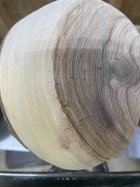See pict. This is a hickory blank I bought about 2 yrs ago. Was coated in wax and stored outside but under cover in northern FL. My shop is too small to be able to store everything. And no…… I can’t do a bigger shop
Turned the outside two days ago and left in lathe to do some final shear scraping before sanding, reversing and turning inside.
Checks not present two days ago. Hard to tell how deep they are/will get.
Should I be worried?
Did I do something wrong?
Anything I can do?
I don’t mind the visual aspects - just don’t want it to blow up and/or fall apart after done, finished etc.
Thanks in advance for any info or guidance

Turned the outside two days ago and left in lathe to do some final shear scraping before sanding, reversing and turning inside.
Checks not present two days ago. Hard to tell how deep they are/will get.
Should I be worried?
Did I do something wrong?
Anything I can do?
I don’t mind the visual aspects - just don’t want it to blow up and/or fall apart after done, finished etc.
Thanks in advance for any info or guidance

